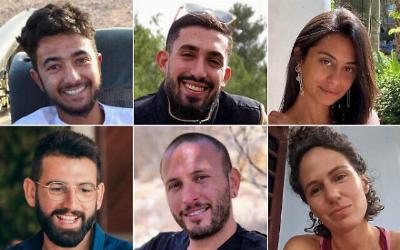Share
Human Rights Voices
While the UN devotes its human rights operations to the demonization of the democratic state of Israel above all others and condemns the United States more often than the vast majority of non-democracies around the world, the voices of real victims around the world must be heard.
Palestinian Authority/Gaza, October 20, 2024
Six slain hostages were likely Sinwar’s shields, lived for months on energy bars
Original source
The six Israeli hostages murdered in a Rafah tunnel at the end of August were likely human shields for Hamas leader Yahya Sinwar and survived for months on energy bars until they were finally executed, too weak to be moved with the terror chief, a TV report said on Saturday.
The Channel 12 investigation shed light on why Sinwar, long believed to have surrounded himself with a group of hostages as human shields, left the tunnels of Rafah, and was without any captives around him when he was killed by the IDF on Wednesday. It also provided new details on the last months, weeks, and days of some of the most high-profile Israeli hostages.
According to the report, the six captives — Hersh Goldberg-Polin, Eden Yerushalmi, Ori Danino, Alex Lobanov, Carmel Gat, and Almog Sarusi — were kept further north in Gaza in the first month of the war, following their abductions by Hamas terrorists on October 7, 2023, from the Nova music festival and, in the case of Gat, her home in Kibbutz Be’eri.
In November, as part of the weeklong ceasefire-hostage deal with Hamas that saw the release of 105 civilian hostages, Israel agreed not to carry out surveillance in the territory during specified hours, while the truce lasted. During that time, the terror group transported some remaining hostages to new locations, the report said — including to Rafah, where the IDF had not yet entered.
Goldberg-Polin, Danino, and Sarusi — all of whom were wounded during their abduction from the Nova festival — were transported in one vehicle, while Yerushalmi, Lobanov, and Gat were transported in another, the report said.
It was not clear from the report how many other hostages were also moved during this time.
Hamas moved the six hostages to a tunnel three stories (20 meters, or 65.6 feet) belowground, the report said. The hostages’ captors reportedly resided in a building aboveground, with a shaft leading down to the captives.
The six Israelis were apparently kept in this tunnel system the entire remainder of their lives, subsiding mostly on energy bars, according to the report.
The hostages were placed in the corridor where they would eventually be killed — which was even harder to reach and had worse conditions than where they’d been held before, in the same system — after Israeli troops rescued four hostages alive in central Gaza’s Nuseirat in June.
On August 21, when the IDF was operating in the area, pursuing intelligence that Sinwar was likely in the vicinity, troops reportedly spotted and attacked a group of some 26 terror operatives, most of whom were killed or wounded.
Those men, Channel 12 reported, included Hamas terrorists who had been guarding the six hostages for some eight months. Other longtime guards of the six fled amid the IDF operations, the report said.
Those captors were reportedly replaced by two relatively junior operatives, who were instructed to kill the captives if the IDF closed in on their location.
Toward the end of August, the new captors perceived a threat to their lives — though it is not known exactly what prompted the feeling — raced from a separate part of the tunnel network to the corridor where the hostages were held, and shot them dead, according to the report.
Upon discovering the hostages’ bodies on August 31, Israeli forces also recovered, a short distance from where the captives had been kept, DNA from Sinwar, which experts said testified to his presence at some point between August 21 and August 27.
The terror leader — who was killed on Wednesday not far from where the hostages were found — was long believed to be surrounding himself with Israeli captives, and the security agencies believe that in all likelihood these six were his human shields, the report said.
The hostages’ bodies testified to a struggle, as has been previously reported. One hostage had shielded Carmel Gat, and another managed to escape several meters before being killed, the report said.
Channel 13 in September cited “forensic” findings showing “Hersh, Ori, Alex and Almog defended Eden and Carmel.”
The hostages’ bodies also evidenced malnourishment and frailty, partly explaining why they were not moved along with the Hamas leader as he sought to outrun Israeli forces — they were too weak.
It was previously reported that Eden Yerushalmi appeared to have been starved, and had lost 10 kilograms in captivity, weighing only 36 kilograms (79 lbs) when she was recovered.
Sinwar “didn’t escape with them, because it’s impossible to escape with hostages like them; they have trouble walking, trouble moving,” a security source told Channel 12, adding that any female figures seen in the area would arouse suspicion, as there are only men there.
The guards who murdered the hostages were discovered and killed by the IDF on August 31, shortly before the discovery of the Israelis’ bodies, the report confirmed...

